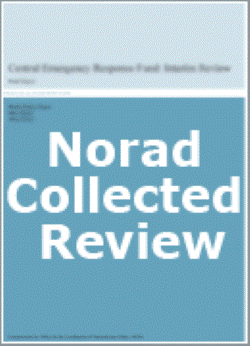Norwegian Refugee Council Review and appraisal 1) “Strengthening Child Protection Mechanisms through Emergency Education Support to Northern Districts of Kitgum and Pader” 2) “Education for Protection and Recovery
Om publikasjonen
- Utgitt: januar 2009
- Serie: Norad-innsamlede rapporter
- Type: --
- Utført av: Norwegian Consulting Group by Janne Lexow and Beatrice Ngonzi
- Bestilt av: The Norwegian Embassy in Kampala, Uganda
- Land: Uganda
- Tema: Utdanning og forskning
- Antall sider: 44
- Serienummer: 32/2008
- ISBN: 978-82-7548-360-5
- ISSN: --
- Prosjektnummer: UGA-03/313, UGA-06/004, UGA-06/ 064

The Project
Norwegian Refugee Council (NRC) began working in Northern Uganda in 1997 and added education to its humanitarian interventions in 1999 (Gulu Primary Education Project). The Norwegian Embassy in Kampala has provided support to the project "Strengthening Child Protection Mechanisms through Emergency Education Support to the Northern Districts of Kitgum and Pader" since 2004. The project purpose is "improved local capacity for a responsive and inclusive education system". The target groups are children, teachers and local education authorities. The project encompasses teacher training, construction of schools, emergency initiatives and school farming and has received NOK 36, 3 mill. for the period 2004-2007. The combined end review and appraisal of a new initiative (focusing on education recovery primarily in Pader), was performed in 2008.
Interesting Findings
Efficiency: school construction efficiency in project implementation has to a large extent been ensured through a transparent tendering process and mechanisms to ensure quality during the construction process. However, availability of contractors, materials and accessibility during the rainy season and in addition the "emergency mode of operation" which follows a strict one-year funding schedule may sometimes hinder the pursuit of quality in all aspects of the construction process.
Overall project activities exceeded their targets indicating good value for money. The exception of 13% less teachers that have been trained compared to the target is acceptable, in particular because the training had to be conducted during the holidays, that some teachers went to other training institutions to upgrade their qualifications, and transfer of teachers.
Effectiveness: Implementation of project activities has contributed to realisation of the project goal and purpose in two major aspects. On the supply side the project has contributed to fulfilment of right to education through construction/rehabilitation of classrooms and provision of school furniture. On the demand side the teacher training component has enhanced the capacity of teachers to use appropriate teaching methods while the emergency education initiatives have ensured continuity in school activities. Provision of a conducive teaching environment has been ensured through teacher housing construction and provision of furniture.
Gender: There is a huge gender gap in enrolment and retention which has been addressed by constructing latrines, training of teachers and emphasising the importance of girls' education in the mobilising of the communities. So far however, there is no evidence to demonstrate that provision of gender sensitive sanitation facilities has improved enrolment and retention of the girl child.
The project has been weak in gender mainstreaming and a number of measures have been taken to address this gap. These include mainstreaming gender as a cross cutting issue in all the project components, identification of a gender and protection focal point person who will be responsible for identification of gender concerns. Instruments have also been developed to track impact of interventions designed to ensuring high enrolment and retention of the girl child. These instruments and measures have not yet been put into practice.
Appraisal of new proposal: The new project proposal for the project "Education for Protection and Recovery" includes most of the components that were first piloted in Gulu and then later in Kitgum. NRC has good experience with these components and the government partners and other actors perceive NRC as an efficient and effective implementer in these areas. The review team therefore recommends that the Norwegian Embassy continues to support NRC in these areas.
Other: NRC has involved the District Education Authorities in identification of schools to be constructed, teachers to be trained and joint inspection missions. The District Education Officers (DEO) has also been trained in the INEE Minimum Standards for Emergency Education and as facilitators in the teacher training programme. However, DEOs are understaffed and under resourced, and are therefore not well positioned to take on the coordinating role. The team therefore recommends that NRC should make deliberate efforts to build the capacity of local authorities to ensure sustainability of activities.
